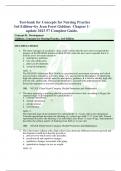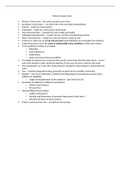-
1. Examen - Test bank burns' pediatric primary care 7th edition test bank test bank questions and...
-
2. Examen - Test bank for primary care art and science of advanced practice nursing – an interp...
-
3. Examen - Microbiology an introduction 13th edition by tortora test bank
-
4. Examen - Advanced practice nursing proffesion 3rd edition test bank questions and aswers grade...
-
5. Examen - A programmer’s guide to java™ scjp certification third edition
-
6. Examen - Consumer behavior buying, having, and being eleventh edition
-
7. Examen - Usmle step 1 l an g e q &a™ sixth editionmichael w. king, phd professor department ...
-
8. Examen - Cherry & jacob: contemporary nursing: issues, trends, and management, 7th edition cha...
-
9. Examen - Test bank for quick and easy medical terminology 9th edition by leonard all chapters ...
-
10. Examen - Chapter 01:introduction to the human body herlihy: the human body in health and illne...
-
11. Examen - Nursing misc medical surgical nursing 10th edition lewis test-bank questions and answ...
-
12. Examen - Test-bank-principles-of-anatomy-and-physiology-12thedition-by-bryan-derrickson-gerald...
-
13. Examen - Test bank for fundamentals of nursing 11th edition chapter 01: nursing today potter: ...
-
14. Examen - Test bank complete for seidel’s guide to physical examination 9th edition test bank...
-
15. Examen - Psychotherapy for the advanced practice psychiatric nurse, third edition: a how-to gu...
-
16. Examen - of nursing 9th edition by taylor, lynn, bartlett test bank | chapter 1-46 |complete ...
-
17. Examen - Roach's introductory clinical pharmacology 11th edition testbank
-
18. Examen - Test bank for ethics, jurisprudence and practice management in dental hygiene 3rd edi...
-
19. Examen - Atls pretest 10th edition answers 2019
-
20. Examen - Test bank for pharmacotherapeutics for advanced practice: a practical approach 5th ed...
-
21. Examen - Understanding- pathophysiology =7th= edition test bank chapter 1
-
22. Examen - New community andpublic health nursing= 10th edition 2023 rector test bank chapter 1
-
23. Examen - Test - bank for varcarolis' - foundations of psychiatric=mental health nursing= 9th e...
-
24. Examen - Pediatric - nursing the critical componen ts of nursing care = 2nd edition rudd test ...
-
25. Examen - Test- bank for pediatric -nursing the critical compo nents of nursing care= 2nd editi...
-
26. Examen - Fundamentals of nursing active learning for collaborative practice 3rd edition yoost ...
-
27. Examen - Test bank for lewis's medical-surgical nursing: assessment and management of clinical...
-
28. Examen - Focus on adult health medical surgical nursing =2nd edition 2023 honan test bank | co...
-
29. Examen - Test bank for financial accounting 15th edition by warren true / false
-
30. Examen - Test bank for current medical diagnosis and treatment= 2023 62nd edition by by maxine...
-
31. Examen - Foundations of maternal newborn and womans health nursing 7th edition test bank chapt...
-
32. Examen - Test bank for brunner & suddarth's textbook of medical-surgical nursing, 15th edition...
-
33. Examen - Test-bank = introduction to maternity and pediatric nursing, 9th edition (leifer, 202...
-
34. Examen - Complete test- bank for lehne's pharmacology for nursing care 11th edition chapter 1-...
-
35. Examen - Medical surgical nursing 10th edition ignatavicius test bank latest update 2023 chapt...
-
36. Examen - Lpn to rn transitions 4th edition test-bank test-bank for lpn to rn transitions 4th e...
-
37. Examen - Test bank for fundamentals of nursing 10th edition 2023 by taylor chapter 1-47 | comp...
-
38. Examen - Lewis's medical surgical nursing test bank 11th edition harding test bank - lewis's m...
-
39. Examen - Test-bank for introduction to maternity and pediatric nursing 9th edition=by gloria l...
-
40. Examen - Test-bank for=primary-care art and science of advanced practice nursing-an interprofe...
-
41. Examen - test-bank for=clinical manifestations and assessment of respiratory disease=7th edit...
-
42. Examen - Nrsg=113 test-bank = maternal child nursing care=by perry -6th edition- new update 20...
-
43. Examen - Urinalysis and body fluids 7th edition test bank latest revised latest update 2023 / ...
-
44. Examen - Medical surgical nursing 10th edition ignatavicius test bank medical surgical nursing...
-
45. Examen - Test-bank for- anatomy & physiology= an integrative approach = 4th edition- michael m...
-
46. Examen - Test-bank for = gerontological nursing = 10th edition by eliopoulos latest update 202...
-
47. Examen - Test-bank complete for = foundations of maternalnewborn and women’s health nursing ...
-
48. Examen - Answers olds maternal newborn nursing and womens health across the lifespan 11th edit...
-
49. Examen - Test-bank for fundamentals of nursing 10th edition = taylor 2023/2024 , 9781975168155...
-
50. Examen - Test-bank - olds' maternal-newborn nursing & women's health across the lifespan, 11th...
-
51. Examen - Test bank for leadership roles and management functions in nursing theory and applica...
-
52. Examen - Test-bank for maternal child nursing care 7th edition = by shannon e. perry, marilyn ...
-
53. Examen - Psych-2800-testbank-1-4&5-8 drugs and the neuroscience of behavior an introduction to...
-
54. Examen - Fundamentals of nursing 10th edition potter perry test bank chapter 1. nursing today
-
55. Examen - Test-bank for gould's pathophysiology for the health professions 7th edition vanmeter...
-
56. Examen - The human body in health and disease -7th edition =by patton testbank chapter 01: int...
-
57. Examen - Test-bank for concepts for nursing practice 3rd edition=by jean foret giddens chapter...
-
58. Examen - Maternity and pediatric nursing 4th edition ricci kyle carman – test-bank test bank...
-
59. Examen - Test-bank for mccance pathophysiology the biologic basis for disease in adults and ch...
-
60. Examen - Test bank for rn ati fundamentals (all chapters 1- 58 with questions and answers)/fun...
-
61. Examen - Basic and clinical pharmacology 15theditionkatzung trevor test bank update 2023/2024t...
-
62. Examen - Nutritional foundations and clinical applications 7th edition grodner test bank compl...
-
63. Examen - 2023 complete solution manual operations management 14th edition stevenson management...
-
64. Examen - 2023 test-bank for pathophysiology: the biologic basis for disease in adults and chil...
-
65. Examen - Urinalysis and body fluids 7th edition test bank latest revised graded a+ 2023 / 2024
-
66. Examen - Complete test bank radiographic pathology for technologists 8th edition kowalczyk que...
-
67. Examen - Chapter 01: introduction to anatomy and physiology cooper: adult health nursing, 9th ...
-
68. Examen - Complete introduction to critical care nursing 8th edition sole questions & answers w...
-
69. Examen - Test bank for fundamentals of 10th edition by taylor chapter 1-47 with ngn complete s...
-
70. Examen - 2023 basic and clinical pharmacology 14th edition katzung trevor test bank chapter 1....
-
71. Examen - Community and public health nursing 3rd edition demarco walsh test bank. verified ori...
-
72. Examen - Fundamentals of nursing 10th edit potter perry test-bank latest stuvia.com - the mark...
-
73. Examen - Advanced practice nursing, 6 th edition testbank chapter 1: highlights from the histo...
-
74. Examen - Test bank psychiatric mental health nursing 8th edition by shelia videbeck |chapter 1...
-
75. Examen - Solution manual for a first course in probability 10th edition / all chapters full co...
-
76. Examen - Chemistry 2nd set first test / chemistry atoms first 2nd edition flowers test bank te...
-
77. Examen - Test bank for lewis's medical surgical nursing in canada, 5th edition / test bank for...
-
78. Examen - Mathematical statistics / solution manual for modern mathematical statistics with app...
-
79. Examen - Introduction to global politics, brief third edition / introduction to econometrics (...
-
80. Examen - Introduction to global politics, brief third edition / introduction to econometrics (...
-
81. Examen - Pharmaceutical: cnpr license exam / answer key for 16th edition cnpr pharmaceutical s...
-
82. Examen - Phlebotomy essentials 6th edition chapter 1, phlebotomy essentials 6th edition chapte...
-
83. Examen - Pnr 140 test bank for success in practical vocational nursing 9th edition by knecht l...
-
84. Examen - Test bank for foundations for populatio n health in community public health nu rsing ...
-
Montrer plus





